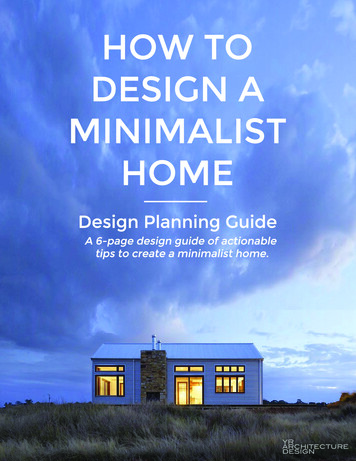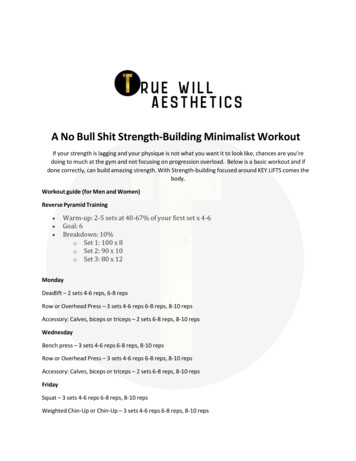
Transcription
How To Design aMinimalist HomeA Design Planning GuideMinimalism is about being able to comfortably live with less clutter and visualtension. By focusing on a handful of elements it’s not necessarily living with less, it’schoosing to draw attention to the shape, color, and texture of the things and spaces weinhabit rather than cluttering them up with stuff.While a minimalist home design seems easy to achieve, it’s actually harder than itlooks. In fact, a beautiful, functional, minimalist home takes skill, restraint, mindfulness,and a lot of discipline. It's about choosing order, clarity, calmness and intention. It'sabout simplicity in forms, materials, and details.What follows are key ingredients and practical tips to create a minimalist home. Byfollowing these minimalist tips you, too, can create a beautiful minimalist home design.This guide includes sections on: Exterior Architecture Interior Architecture Interior Designwww.yr-architecture.com
How To Design a Minimalist Home(A Design Planning Guide)Exterior Architecture:1. Simplicity in form and function creates clarity. Spaces are more predictable anduncomplicated.Create a simple, straightforward plan layout.o Create an efficient, compact floor plan that avoids a lot of ins and outs, complex anglesor curves - rectilinear floor plans are most common.o Be functional and deliberate in your space layout. Are all spaces essential?o Avoid a lot of level changes for clarity.Create a simple building form and volumes of space.o Stack volumes of space on top of each other. This helps prevent a lot of ins & outs, too.o Simplify the roof planes by avoiding complex roof geometries & reduce the number ofroofs/roof pitches.o Create simple, uncomplicated openings for doors and windows.2. Uncomplicated cladding and detailing provide visual appeal and articulation simplifying the facade and drawing attention to the physical characteristics of thematerials & their texture.Create a simple exterior cladding strategy.o Use continuous, uninterrupted exterior cladding, instead of a hodgepodge of claddingoptions.o Be mindful of material lengths and sizes. Be deliberate in the locations of joints andsplices.o Limit the material palette to a few different exterior materials.o Limit the color palette to 2-3 colors.Simplify and minimize exterior detailing.o Create simple details around window and door openings.o Simplify how cladding material terminates at the top, bottom, corners, and edges of thewalls.o Avoid a lot of ornate decoration (simplify the railing design, cornice/soffit details, etc).Notes:www.yr-architecture.compg1
How To Design a Minimalist Home(A Design Planning Guide)Interior Architecture:1. Create clean, open, light-filled spaces.Create open floor plans to further create a clear, predictable floor plan that showsrelationship between areas.Be deliberate in the locations of interior walls. Avoid random walls that break up openspaces or make spaces feel confined.Provide an abundance of natural daylight to make the spaces feel open, light-filled, andenhance the ambiance - helping it feel warm and cozy more than cold and sterile.2. Create a simple, deliberate interior material strategy.Limit the material palette to a few materials for a consistent, unified aesthetic throughout.Tie materials together from room to room to make visual connections and add interest.Strategically use wall, floor, and ceiling accent materials for visual interest, texture, andpersonality in lieu of relying on accessories or objects that clutter the spaces. But don’t gooverboard. Keep most surfaces simple, and include one or two highlight surfaces.3. Simply and minimize interior detailing.Create simple details for stairs, cabinetry, and trim work.Create simple and consistent trim packages for any trim (base, window/door, etc).Minimize or eliminate crown moulding, chair rail, and kitchen cabinetry trim work.Avoid decorative detailing by paring down the details to what is necessary. (Ex, avoidornate door and cabinetry hardware)Expert Tip: Set up imaginary grids or alignments between different architectural elementswithin a space (i.e. walls, edges, fixtures, joints in materials). Be deliberate in their placementto reduce visual tension in the spaces by avoiding small misalignments and things that looklike a "mistake" or afterthought. Align fixtures with windows, center outlets on walls or under alight switch, etc.Notes:www.yr-architecture.compg2
How To Design a Minimalist Home(A Design Planning Guide)Interior Design/Decor:1. WallsUse neutral/light colored walls to keep the spaces bright and light-filled.Design for clean, uncluttered walls. Use a few nice pieces of artwork, shelves, or framedobjects to accent the wall, but avoid a lot of decoration.Let the view outside become the canvas for the walls. Make the exterior view the focalpoint with windows.2. FurnitureStick to simple furniture and locate them strategically.Think of which pieces are essential and which can serve dual purposes.Give furniture and objects plenty of space (give each piece some breathing room).3. AccessoriesSelect a few objects and accessories to display and store the rest out of sight in drawersor cabinets.For functional accessories, select simple clean items over decorative ornate ones. (Ex.modern window shades over decorative drapery with complicated pleats, folds, bands,rings, rods, and valances)Keep surfaces and floors clean and clear of clutter.Design Tips:You can break some of the rules with accents, splashes of color, or playful elements. Justdon't go overboard.Think: quality over quantity.Notes:www.yr-architecture.compg3
How To Design a Minimalist Home (A Design Planning Guide) www.yr-architecture.com pg 3 Interior Design/Decor: 1. Walls Use neutral/light colored walls to keep the spaces bright and light-filled. Design for clean, uncluttered walls. Use a few nice pieces of artwork, shelves, or framed o










